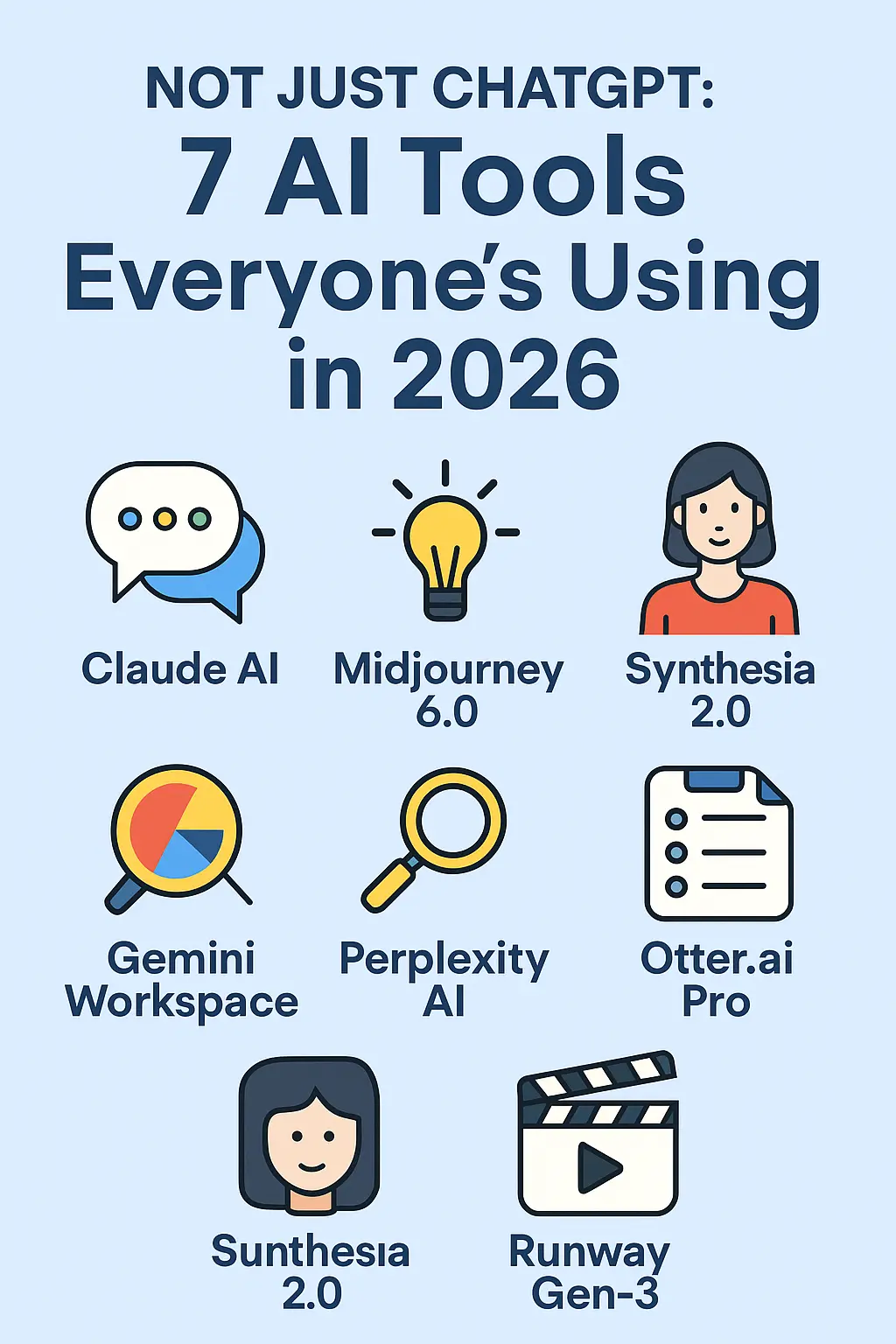Artificial Intelligence continues to dominate the workplace, but by 2026, it’s not just about ChatGPT anymore. A wave of new AI tools are shaping how professionals learn, work, and innovate across industries. From design and data analytics to productivity and governance, these tools are becoming everyday essentials.
If you want to stay ahead of the curve, you need to know what’s trending now. This article explores the 7 AI tools everyone’s using in 2026, their applications, and why they matter for your career.
Why AI Tools Dominate in 2026
- Mainstream adoption – AI has moved from “early adopter” to everyday workplace necessity.
- Cross-industry relevance – From healthcare to education, every sector uses AI-powered solutions.
- Productivity multiplier – AI cuts hours of repetitive work into minutes.
- Competitive edge – Employers increasingly prefer candidates fluent in using AI tools.
Just as spreadsheets once defined the modern office worker, AI tools in 2026 define the next generation of professionals.
1. Claude AI – The Conversational Powerhouse
While ChatGPT remains popular, Claude AI has gained traction in 2026 for its ability to handle longer documents, nuanced conversations, and legal-style reasoning.
- Use cases: Contract analysis, policy drafting, academic research.
- Why it matters: Professionals value Claude for accuracy and depth, making it a go-to tool beyond casual AI chats.
2. Midjourney 6.0 – The Visual Creation Standard
By 2026, Midjourney 6.0 is the leading AI design tool, producing near-photorealistic images and brand-ready visuals.
- Use cases: Marketing campaigns, product design, advertising.
- Why it matters: Creative professionals without graphic design backgrounds now create studio-quality assets in minutes.
3. Gemini Workspace – The Integrated Productivity Suite
Google’s Gemini Workspace has become an enterprise staple in 2026, embedding AI across Gmail, Docs, Sheets, and Slides.
- Use cases: Automated reporting, meeting summaries, predictive email drafting.
- Why it matters: It’s less about “new tools” and more about AI-enhanced workflows inside the apps people already use.
4. Synthesia 2.0 – The Video Training Essential
Synthesia 2.0 now powers onboarding and training in Fortune 500 companies. It allows leaders to create professional training videos with AI avatars in multiple languages.
- Use cases: Corporate training, onboarding, global communication.
- Why it matters: Companies save millions by cutting video production costs while scaling training worldwide.
5. Perplexity AI – The Research Assistant
By 2026, Perplexity AI has become a trusted AI search tool, combining conversational AI with verified citations.
- Use cases: Market research, academic projects, competitive intelligence.
- Why it matters: Unlike standard search, Perplexity provides contextualized, sourced insights, making it indispensable for decision-making.
6. Otter.ai Pro – The Meeting Intelligence Hub
Meetings remain central to work, but Otter.ai Pro in 2026 transforms them into intelligence systems.
- Use cases: Summaries, action-item tracking, decision logs.
- Why it matters: Instead of forgetting discussions, teams build searchable knowledge bases with AI.
7. Runway Gen-3 – The AI Video Creator
Runway Gen-3 dominates the AI video creation space in 2026. Unlike earlier versions, Gen-3 produces cinematic-quality video content with simple prompts.
- Use cases: Marketing videos, short films, product explainers.
- Why it matters: Democratizes video production for startups, educators, and creatives.
How Professionals Use AI Tools in 2026
- Marketers use Midjourney and Runway to launch entire campaigns in hours.
- Consultants rely on Claude and Perplexity for fast insights.
- Executives depend on Gemini Workspace and Otter Pro to manage time and decisions.
- Educators adopt Synthesia for multilingual learning.
Mastering these AI tools is no longer optional — it’s a career requirement.
Choosing the Right AI Tools for Your Career
- Match tools to your role – Marketers vs data analysts need different toolkits.
- Experiment widely – Test multiple platforms to find what integrates best with your workflow.
- Stay updated – AI tools evolve rapidly; what works in 2025 may be outdated by 2026.
- Document your projects – Build a portfolio to prove how you’ve used AI tools in real work.
Conclusion: The Future Belongs to AI-Ready Professionals
By 2026, it’s clear: AI tools aren’t just optional upgrades — they’re the backbone of modern work. From Claude to Runway, these platforms redefine productivity, creativity, and strategic insight.
To stay competitive, every professional needs to learn, test, and integrate these AI tools into their daily workflows.
Explore structured learning programs at TheCaseHQ to combine hands-on projects with AI certification, and ensure you’re ahead of the curve.
Visit our other human resource certifications
Visit our other artificial intelligence certifications
Visit our other digital technology certifications
Visit our other higher education certifications
Visit our other quality and lean six sigma certifications
Visit our other strategy and management certifications
Read More:
Exciting Vision: What Will the AI-Native Classroom Look Like by 2030?
Essential Guide: Should Educators Be Trained in Prompt Engineering?
Comprehensive Comparison of Gen AI Tools: ChatGPT, Claude, Gemini, and More
Plagiarism or Productivity? The Truth About AI Use in Student Work
Critical Analysis: How Students Use Gen AI for Essay Writing—Should We Be Concerned?
Essential Comparison of CLSSGB vs CSSGB: Which Six Sigma Green Belt Is Right for You?



Responses